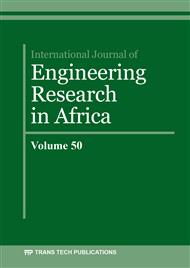[1]
V. Te Chow, Handbook of Applied Hydrology. New York: McGraw Hill, (1964).
Google Scholar
[2]
E. M. Shaw, K. J. Beven, N. A. Chappell, and R. Lamb, Hydrology in practice. CRC press, (2010).
Google Scholar
[3]
B. U. Ngene, Rainfall Analysis for Estimating Design Runoff: Case Study of North Central Zone of Nigeria,, Unpublished M.Eng Project submitted to the Federal University of Technology,Owerri, (2000).
Google Scholar
[4]
L. Oyebande, Deriving rainfall intensity-duration-frequency relationships and estimates for regions with inadequate data,, Hydrol. Sci. J., vol. 27, no. 3, p.353–367, (1982).
DOI: 10.1080/02626668209491115
Google Scholar
[5]
G. I. Okonkwo and C. C. Mbajiorgu, Rainfall intensity-duration-frequency analysis for Southeastern Nigeria,, Agric. Eng. Int. CIGR J., vol. 12, no. 1, (2010).
Google Scholar
[6]
A. S. Awofadeju, A. O. Akanni, T. A. Ojeleke, and A. A. Oguntayo, Development of Rainfall Intensity-Duration-Frequency Curves for South Western Nigeria,, Int. J. Eng. Technol., vol. 10, no. 4, p.373–379, (2018).
Google Scholar
[7]
E. J. Gumbel, Statistical theory of extreme values and some practical applications: a series of lectures, vol. 33. US Government Printing Office, (1948).
Google Scholar
[8]
P. F. Rasmussen, The POT method for flood estimation: a review,, Extrem. Values Flood Droughts, Stoch. Stat. Methods Hydrol. Environ. Eng., vol. 1, p.15–23, (1994).
Google Scholar
[9]
K. B. Chang, S. H. Lai, and F. Othman, Comparison of Annual Maximum and Partial Duration Series for Derivation of Rainfall Intensity-Duration-Frequency Relationships in Peninsular Malaysia,, J. Hydrol. Eng., vol. 21, no. 1, p.05015013, Jan. (2016).
DOI: 10.1061/(asce)he.1943-5584.0001262
Google Scholar
[10]
V. Agilan and N. V. Umamahesh, Non-Stationary Rainfall Intensity-Duration-Frequency Relationship: a Comparison between Annual Maximum and Partial Duration Series,, Water Resour. Manag., vol. 31, no. 6, p.1825–1841, Apr. (2017).
DOI: 10.1007/s11269-017-1614-9
Google Scholar
[11]
C. F. A. Teixeira, R. de C. F. Damé, and J. L. C. Rosskoff, Intensity-duration-frequency ratios obtained from annual records and partial duration records in the locality of Pelotas - RS, Brazil,, Eng. Agrícola, vol. 31, no. 4, p.687–694, (2011).
DOI: 10.1590/s0100-69162011000400007
Google Scholar
[12]
K. B. Chang, S. H. Lai, and O. Faridah, RainIDF: automated derivation of rainfall intensity–duration–frequency relationship from annual maxima and partial duration series,, J. Hydroinformatics, vol. 15, no. 4, p.1224–1233, Oct. (2013).
DOI: 10.2166/hydro.2013.192
Google Scholar
[13]
J. C. I. Dooge, Walter Langbein and the emergence of scientific hydrology,, Water Resour. Res., vol. 32, no. 10, p.2969–2977, Oct. (1996).
DOI: 10.1029/96wr00273
Google Scholar
[14]
W. B. Langbein and W. G. Hoyt, Water facts for the Nation's future: Uses and Benefits of Hydrologic Data program. New York: The Ronald Press Company, (1959).
Google Scholar
[15]
H. U. Nwoke, I. L. Nwaogazie, and B. C. Okoro, Dimensional analysis in rainfall intensity modeling: A case of selected cities in south-eastern Nigeria,, Prime J. Phys. Sci., vol. 1, no. 2, p.24–27, (2012).
Google Scholar
[16]
I. L. Nwaogazie and E. O. Duru, Developing Rainfall Intensity Duration-Frequency Models for Port Harcourt City,, NSE Tech. Trans., vol. 37, no. 2, (2002).
Google Scholar
[17]
B. U. Ngene and N. Obianigwe, Nigerian Rain Gauge Station Optimization and National Development: The importance of HeadCount,, IOP Conf. Ser. Mater. Sci. Eng., vol. 413, no. 1, (2018).
DOI: 10.1088/1757-899x/413/1/012022
Google Scholar
[18]
T. Dunne and L. B. Leopold, Water in Environmental Planning. New York: Wall H. Freeman and Company, (1978).
Google Scholar
[19]
S. K. Garg, Hydrology and Water Resources Engineering. Nai Sarak Delhi, India: Khanna Publishers, (2005).
Google Scholar
[20]
P. A. C. Okwuobi, Intensity Duration-frequency distribution for Benin-City,, Niger. Eng., (1979).
Google Scholar
[21]
I. L. Nwaogazie, Probability and Statistics for Science and Engineering Practice, 3rd ed. Port-Harcourt, Nigeria: University of Port Harcourt Press, (2011).
DOI: 10.54117/ipsintelligentsiabooks/082021
Google Scholar


